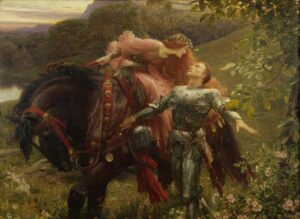Although Coleridge explicitly depicts traditional gender roles and dynamics in the first half of “Christabel”, he inverts these gender norms in the second half of the poem through the characterization of Christabel and her relationship with Geraldine. The speaker introduces Christabel as a well-off young woman with dreams of meeting a knight and falling in love; the speaker repeatedly uses the phrase “lovely lady” when first describing or referring to Christabel (l. 23, 38, 47). The alliterative nature of this phrase emphasizes the soft, light “L” sound, which exudes the same daintiness that thus far characterizes Christabel. Additionally, the word “lovely” has feminine connotations within the gender binary due to the beauty and mannerism standards for women; Christabel, then, is considered lovely due to her adherence to traditional gender standards. The phrase “lovely lady” ultimately situates her well within the traditional gender expectations for women.
In the poem, Christabel leaves the castle to pray under a tree when she meets Geraldine. Meeting Geraldine and learning about her situation initiates Christabel’s shift from fulfilling a traditionally feminine gender role to a more masculine one. Because Geraldine, who the speaker repeatedly characterizes as “faint and sweet”, describes being captured by a group of men, she portrays the “damsel in distress” trope (l. 68, 73). Christabel, by saving Geraldine and taking her to safety, then acts as the savior of the damsel in distress. Traditionally, a knight or other prominent male figure fulfills this savior role, but having Christabel save the damsel inverts gender roles and shows a sense of female agency. By physically lifting Geraldine over the gate, tending to Geraldine’s needs, and eventually sleeping with her, Christabel’s displays of agency subtly align with the traditionally masculine traits of physical strength and sexual prowess. This implies that although Christabel has agency, the only legitimate form of agency is that which stems from traditionally masculine values. The consequences of Christabel’s agency also promote this patriarchal ideology, as it becomes clear that the “damsel in distress” being saved is actually some sort of witch, demon, or other dangerous and mystical being. Considering her true identity, Geraldine gaining access to Christabel’s home has dangerous implications, and it is due to Christbel’s displays of agency that Geraldine has this access in the first place. Therefore, Christabel’s inverted gender roles does more harm than good and reinforces the idea that women should not stray from their expected gender roles.

